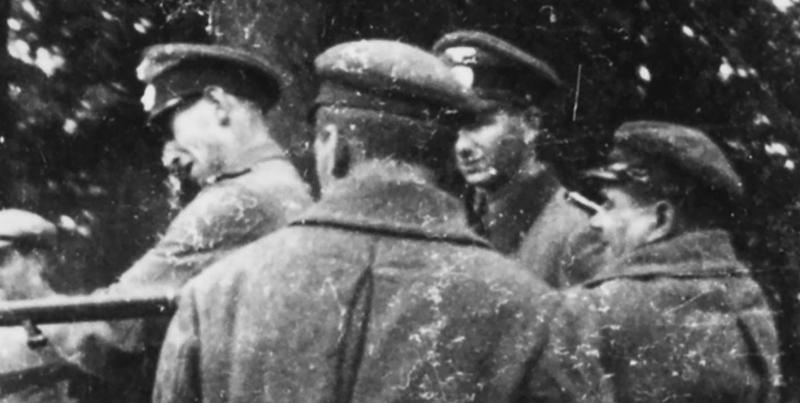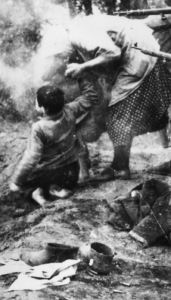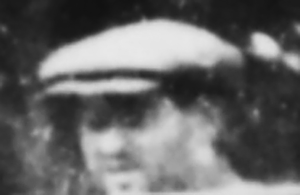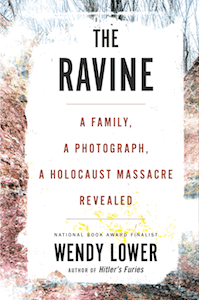
To Catch a Killer: Uncovering the Massacre of a Jewish Family in
Nazi Europe
Wendy Lower's Ten-Year Hunt to Identify the Victims and Murderers in a Horrific Holocaust Photograph
In August 2009 I was in the archives of the United States Holocaust Memorial Museum, searching for Nazi documentation that might lead to the prosecution of the highest-ranking SS officer known to be alive in Germany at that time. This “last Nazi” was Bernhard Frank, the former commandant of Adolf Hitler’s Berghof compound in the Alps. Frank was a protégé of the SS commander in chief, Heinrich Himmler, who was responsible for carrying out the genocide of European Jews. In the early days of the “Holocaust by bullets,” Frank had certified orders for the first mass shootings to include Jewish women and ensured that the details of those operations were accurately recorded. Between July and October 1941, Frank recorded the murder of more than 50,000 Jewish men, women, and children in the fields, swamps, and ravines of Ukraine and Belarus.
As I was reading microfilmed SS police reports, Vadim Altskan, the museum’s expert on Ukraine, interrupted me and asked if I had time to take a look at something. He introduced me to two young journalists from Prague who wanted to show me a photograph. According to the documentation they provided, it was taken on October 13, 1941, in Miropol, Ukraine.
At first glance, I could see from certain details that the image originated in the Holocaust: the Nazi uniforms, the wartime-era clothing of European civilians, the long-barreled wooden rifles, and a woman and a boy—relatives, perhaps a mother and son—being shot by Germans and local collaborators at the edge of a ravine.
In my decades of researching the Holocaust, I had seen thousands of photographs and closely studied hundreds, looking for images that captured the killers in the act. Too many (like Bernhard Frank, who died in 2011) had gotten away with murder and lying about it under oath. If the perpetrators shown in a photograph could be identified, it could serve as incontrovertible evidence of their participation in murder. These were my impressions and thoughts within seconds of first seeing the photograph.

Although the documentary and photographic record of the Holocaust is greater than that of any other genocide, incriminating photographs like this that catch the killers in the act are rare. In fact, there are so few that I can list them here: an SS officer aiming his rifle at a Jewish family fleeing in the fields of Ivanograd, Ukraine; naked Jewish men and boys being forced to lie facedown in a pit (the “sardine method”) as they are being shot in Ponary, Lithuania; Jewish women and children, at the moment of death, falling into the sand dunes of Liepāja, Latvia; an execution squad firing in Tiraspol, Moldova; naked Jewish women and girls being finished off by Ukrainian militia in Mizoch; one photograph from Ukraine with the caption “last living seconds of Jews in Dubno,” showing men being shot execution-style against a brick wall; another, also from Ukraine, captioned “the last Jew in Vinnytsia,” showing a man kneeling before a pit with a pistol to the back of his head; Jews in Kovno (Kaunas) being bludgeoned to death by Lithuanian pogromists; and a few more without captions, apparently taken in the Baltic states or Belarus and depicting the Holocaust by bullets.
Most of these images have been blown up and displayed in museum exhibitions; many are retrievable on the internet. They are few but represent the murder of millions. These iconic snapshots of the Holocaust give the false impression that such images are numerous, yet they number not many more than a dozen, and we know little, if anything, about who is in them, and even less about who took them.
What does one do upon discovering a photograph that documents a murder? Imagine, by way of comparison, that you are rummaging around in a flea market, an antique store, or the attic in your new home, and you find a photograph that shows a person being killed, with the perpetrator in full view. If the crime seems recent, occurring in your own lifetime, you would probably bring the photograph to a police station and file a report to start an investigation. But what if the crime depicted was a lynching from a century ago? Or a shooting in 1941? The Ravine tells the story of one photograph and its power to hold our attention, reveal a wealth of information about the Holocaust, and demand action.
I asked the journalists about the history of the photograph. Where did they find it? They explained that this photograph from Miropol had been locked in the stacks of Prague’s Security Service headquarters, a former KGB-like authority in Soviet-controlled Czechoslovakia. It took the collapse of the Soviet Union in 1991 to bring to light this image of mass murder—living victims being killed together, as a family. It is astonishing evidence, clearly showing local militia shooting side by side with Germans in wartime Ukraine, where more than a million Jews were murdered in broad daylight. And, the journalists revealed, the photographer testified about this event in the 1950s, stating emphatically that the local killers were Ukrainians who knew some of the victims.
The Holocaust was a German-led attack against the Jews of Europe, and beyond. In recent decades, the vast and deep involvement of non-Germans has come into sharper relief and made collaboration a word as dirty as the mud and blood soiling the killers’ uniforms and shoes. The collaborators pictured here were not prominent quislings, the treasonous fascist leaders in various countries who sided with Hitler. These were instead local police officers who committed murder against their neighbors.
What does one do upon discovering a photograph that documents a murder?
Today, more than 70 years later, eastern European scholars who research and publish information about such local killers in Ukraine, Poland, Hungary, and elsewhere are silenced, threatened, and even criminalized for dredging up the dark past of European anti-Semitism, greed, opportunism, and collective violence. The whitewashing of this historical stain can be seen in revisionist narratives, in state-controlled media, and in security classifications that lock records away in secret archives. But the evidence of local collaboration seen in this vivid crime photograph is as undeniable as the bones of murdered Jews lying in mass graves just below the surface of these eastern European countries.
As soon as I saw the photograph and held it in my hand, I wanted to break the frame around the crime scene, which kept the victims frozen in that awful moment. The photograph captures an event locked in time, but I knew it was part of a fluid situation. What preceded that moment of death, what followed, and what happened to each person visible there? Perhaps in finding the answers, I could unmask the killers and restore some kind of life and dignity to the victims.
Four men are clustered together—an armed gang in loose formation. In the background, we see the two German commanders, and in the foreground and to the right, two Ukrainian militiamen crowding the victims. One German, in a pressed jacket and jodhpurs, and the Ukrainian behind him, in a heavy woolen Red Army coat, have just pulled their triggers.

The victims of this massacre were brought to the edge of the pit and shot so quickly, one after another, that the multiple muzzle blasts have produced halos of smoke that are still hovering in the atmosphere. The Ukrainian’s rifle is inches from the head of the woman, which is obscured in the smoke.
She is bending forward, in her polka-dot housedress, dark stockings, and Mary Jane–style leather shoes. She is holding the hand of a barefoot boy, dressed in a little tailored coat and pants, who is falling to his knees. In the foreground of the photograph a pair of men’s leather booties is positioned as if someone had just taken them off, as if he used the tip of the right shoe to pry off the heel of the left one. Next to the shoes is an empty coat lying on its side, like the shell of a man’s torso at rest. Fired cartridge casings, the litter of the mass murder, are scattered on the ground.

The victims are at the edge of a ravine. The woman is dying from the bullet wound to the head, pulling the boy—who is still alive—down with her into the grave. According to common Nazi protocol, bullets were not to be wasted on Jewish children. They were instead left to be crushed by the weight of their kin and suffocated in blood and the soil heaped over the bodies.
It must have been mid-morning. Rays of light entered the camera’s aperture when this candid was shot, and in the developed print the contrasts are sharp: the boy’s neatly cut dark hair and his stark white face; the shiny leather of a German policeman’s visor, with silver insignias stamped on the cap; the polka dots that pop in the dark folds of the woman’s dress. The forest backdrop looks like a canvas curtain painted with dark vertical tree trunks and blotchy branches.

This is an action shot. There is motion in the moment, in the explosion, in the tense postures and grimaces of the killers, in the cloud of smoke around the woman’s head, and in the kneeling boy holding her hand. A civilian onlooker in a wool cap stands alert, ready to assist.

Mass murder requires a division of labor among a multitude of perpetrators, and in the Holocaust that combined effort cut across ethno-cultural lines. I was to learn that the photographer was a Slovakian security guard, mobilized for the invasion and occupation of the Soviet Union in 1941 and stationed in Nazi-occupied Ukraine. Like millions of other soldiers, he got swept up in the camera craze of the 1920s and 30s, and when he was drafted, he packed his new Zeiss Ikon Contax to document historic events and foreign terrain.
The photographer stands about 20 feet from the executioners (his camera did not have zoom or telephoto lenses), while the helper (possibly an interpreter, gravedigger, or confiscator) walks or stands near him without any expression of alarm; he does not look at the camera. It seems that the photographer is permitted to be there, perhaps as part of the cordon of guards, and is openly snapping pictures at eye level or waist level. The photographer knows what he’s doing—the image is clear and composed. It even follows photography’s basic “rule of thirds” in the positioning of the main panels: the ravine, the dying victims, and the killers. If this photograph had been taken in a clandestine manner (or snapped by an amateur), it might be off-kilter or unfocused, perhaps showing an obstruction such as the seam of a coat pocket or a part of the photographer’s hand.
Looking at this picture, we take on the photographer’s view of the event as he stands among the perpetrators, collaborators, and other onlookers, probably including more Jewish victims waiting to be killed. We see what this close-up observer wished to capture. He opened the lens, adjusted the dial to set the aperture, pointed the camera, and pressed the button. The photograph encapsulates the sensory and the documentary, the aesthetic and the evidentiary—elements elucidated by cultural critics of photography. One might even argue that it includes the pornographic, as the camera is aimed, like the German and Ukrainian guns, at the woman and child.
The photographer, along with the Germans and Ukrainians, partakes in the disturbing intimacy of the violence. Perpetrators stand shoulder to shoulder, close to the victims. They touch the woman with their hands and the ends of their guns. Here we see genocide at its extreme: the final moment when paramilitary gangs of men like this one annihilate women and children.
At the center of the image is what is left of a Jewish family and community in Miropol, a historic Jewish shtetl west of Kiev (now Kyiv). Perhaps the photograph is intended to document the end of the future of Jewry as a matrilineal “race” in Europe. The victims are clothed and will be buried en masse, a violation of Jewish religious rites. They are killed in small family groups and therefore see and feel the suffering of loved ones, including parents viewing the destruction of their own children. This is perhaps the most extreme assault that the genocidaire inflicts. What thoughts ran through this mother’s mind as she was forced to march to this site with her child? Did the boy try to run away, shocked and confused? Was the father killed first, before their eyes? And what does one do with an image of the missing, whose lives and fates have not been registered by anyone?
The photographic documentation of the Holocaust is especially rich because the events coincided with the mass production and consumption of the small handheld camera. During the war, Hitler’s propaganda minister, Joseph Goebbels, embedded 15,000 photojournalists in all theaters of the conflict, producing more than 3.5 million images. The pocket snapshot was a common item in the soldier’s knapsack. And as German soldiers seized and occupied territories formerly held by the Soviet Union in 1941 and 1942, they photographed what they encountered. World War II was not only the most destructive armed conflict ever; it was also the most photographed.
Patriotism, anti-Semitism, lurid fascination with cruelty and death, moral outrage at witnessing genocide, and myriad other motives caused ordinary soldiers to document the spectacles of violence inflicted on Jews, Soviet POWs, resistance fighters, forced laborers, and Slavic “Untermenschen.” The Holocaust of the Jews consisted of six million acts of murder, and the global archive of visual documentation reflects both individual victims and the scale of the genocide. It shows individuals, families, and communities in the years, months, days, and moments leading up to their deaths, and afterward as piles of corpses. We see the culmination of Nazi anti-Semitic policies that forced Jews to endure conditions that necessarily caused death. Yet the act of killing is rarely portrayed. Nazi leaders suppressed images that depicted it, confiscating the most incriminating ones while employing euphemisms, such as the “Final Solution” and “Special Treatment,” to allude to the brutal truth.
World War II was not only the most destructive armed conflict ever; it was also the most photographed.
Photographs, if we choose to study them, open up questions and lead us down paths of discovery. There are details in the Miropol photograph that we were not supposed to witness. Some postwar theorists of photography would urge us not to look at, let alone scrutinize, the suffering of others. In 1988, when scholars and museologists deliberated over the visual content of the United States Holocaust Memorial’s Museum’s exhibits, they explored the “question of explicit imagery including the ‘pornography of murder, nudity and violence in a museum.’”
The museum’s creators were clear that to avoid all graphic visuals—images that elicit shock and outrage—would be to forsake the truth of Nazi evil. They did not want to display victims in a way that would further humiliate them or embarrass their families and descendants, or encourage voyeurism. They feared that images of sexual violence and nude corpses might excite erotic fantasies. Depictions of death “precisely because its meaning eludes us and because it is universal and ineluctable titillate, fascinate, and compel attention.” Viewers should not “lose sight of the fact that each of the corpses in a pile was a single, complex, multi-faceted human being with parents, families, loved ones, personal dreams and expectations and thwarted aspirations.”
The cultural critic Susan Sontag argued that the shock of atrocity photography “wears off with repeated viewings.” I disagree. The risk of desensitization to such images exists when we have no knowledge of their history and content. The more I learned, the more the Miropol image came to life.
One such moment occurred in October 2014. I had asked the technical support services staff at my college to create high-resolution images of the Miropol photograph. We created cutouts from it, like five puzzle pieces, each one containing a feature of the story. One showed the Germans’ faces, one showed the Germans shoulder to shoulder with the Ukrainians, one showed the landscape, one the victims, and one the empty shoes.
I enlarged the cutouts and printed them to study them more closely. I was looking for clues, things to place alongside postwar witness statements about the Miropol massacre in order to put these statements to the tests of veracity, probability, and logic. I focused on each piece. Did the shadows indicate the time of day? Did the clothes, such as the heavy overcoats, suggest a season? What insignia could I identify on the Germans’ uniforms? Were more onlookers hidden behind the figures in the foreground or among the trees? Were the items on the ground papers or leaves? Were the victims holding anything, such as a Bible, or wearing anything of importance, such as a wedding ring?
My eyes were always drawn back to the center, to the crouching woman, and I began to wonder why she was bent over in a perpendicular angle, not buckling under or kneeling forward. And then I saw something resting on the woman’s lap or being held in her right arm. It was a hazy, curved form; light was not passing through what should have been an empty space. I could make out a pair of bent knees and the translucent fabric of a dress. I started to see the faint lines of an elbow and a small head covered in a scarf. Suddenly into my view came the existence of another person, a child. I had found another soul about to be extinguished, another nameless victim of the Holocaust who was meant to be lost to us. These faint contours were the only trace of this child.
Most Holocaust photographs taken by Germans and their collaborators triumphantly document victory over Judeo-Bolshevism. These images show the victims on their way to death—waiting at deportation sites, sitting or standing solemnly among piles of clothes, being selected at the arrival ramp at Birkenau. The photographers leer sadistically at women undressing or standing in the nude. But, as the scholar Ulrich Baer astutely argues, we should not remain locked in the gaze of the onlookers. Rather, we must try our best to restore the victims as subjects, not objects, of history. In the same way, we should interrogate the motive of the photographer, the grimaces of the killers, and the forces of anti-Semitic hate that are being expelled from the ends of their guns and pistols. These things need to be investigated, exposed, and explained.
As the scholar Ulrich Baer astutely argues, we should not remain locked in the gaze of the onlookers. Rather, we must try our best to restore the victims as subjects, not objects, of history.
Only after the collapse of the Soviet Union was it possible to situate this Miropol image within the tens of thousands of pages of investigative material about the mass shooting and to gather dozens of accounts from those in Miropol who had access to the view we see here. They included the villagers who dug the pits, the police officers who drove this family to the edge of the pit, the perpetrators who pulled the triggers, the laborers who covered the mass grave, the forensic investigators who exhumed it in 1986, and the photographer who was haunted by this image until his death, in 2005.
In this postmodern era of research, with its millions of cataloged and digitized documents and the accessibility of sites related to historical events, I was able to draw on every possible remnant of evidence—the written, the visual, and the artifactual records of the perpetrators and their regime; the environmental and architectural landscape of the places where the victims lived and were murdered; and the generations of storytellers from Miropol and around the globe whose family trees contain severed branches dating from the Holocaust. This single photograph of the murdering of a family took me to archives, museums, living rooms, peasant huts, fields, and parks in Europe, America, and Israel.
My book, The Ravine, is about the potential of discovery that exists if we choose to delve in. It is also about the voids that exist in the history of genocide. Its perpetrators not only kill but also seek to erase the victims from written records, and even from memory. When we find one trace, we must pursue it, to prevent the intended extinction by countering it with research, education, and memorialization.
__________________________________

Adapted from The Ravine: A Family, a Photograph, a Holocaust Massacre Revealed. Used with the permission of the publisher, Houghton Mifflin Harcourt. Copyright © 2021 by Wendy Lower.
Wendy Lower
Wendy Lower is the author of the National Book Award and National Jewish Book Award finalist Hitler's Furies, which has been translated into twenty-three languages. Recently the acting director of the Mandel Center for Advanced Holocaust Studies at the U.S. Holocaust Memorial Museum, Lower is the John K. Roth Professor of History and director of the Mgrublian Center for Human Rights at Claremont McKenna College.












